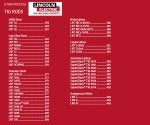I am buying a tig for the first time and I need help in choosing filler rod and tungsten for tig inverter welding.
filler rod for
mild steel
stainless steel
aluminium alloy
Thanks in advance
filler rod for
mild steel
stainless steel
aluminium alloy
Thanks in advance





